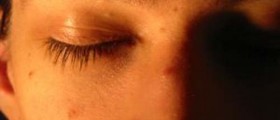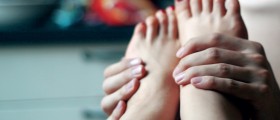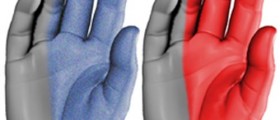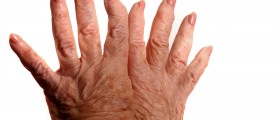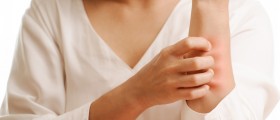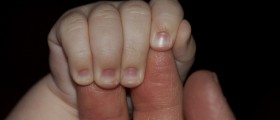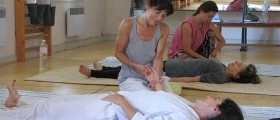Same as everyone else, I suppose I was in great stress the first time it happened, but it was while I was a Massage School. I've always thought that I contracted whatever it is from massaging all those bodies. It comes and goes. I've tried antifungal foot cream (clotrimazole) to the best result. I'm sure stress makes a difference.
Loading...
Worry. This is the prime cause. Fungus is the result. Fungus is hard to heal. From my close observations it has a tendancy to go deeper into the skin than medical science claims. The little worm-like pustules appear to attach themselves to nerve endings. How herpe like. I have a very high pain threshold. I have dental work with no novacaine. The spots on my palm "inhabited" by these pustules which almost seem plantar wart-esque especially in the pain department seems to be rooted. I extracted one with enormous pain but upon extraction and initial bleeding at the spot, it became pain free. Here is what I did. Apple Cider Vinegar in a bowl of ice. The ice kills the stinging. I won't lie. It hurts. I then used OTC athlete's foot powder spray. Generic brands just held it in place. I alternated btw Tolnaftate and Lotrimin, the lotrimin was most effective. After an occasional spray I would apply a layer of tolnaftate cream over clinging powder spray. Little air bubbles formed over infected areas. Pop them. This seems to suffocate the fungus and it also seems to liquify the pustules. The spray dries the hell out of it. Toward the end I also used peroxide spray . I can't stress the importance of ice when using Apple Cider Vinegar or peroxide. Peroxide is so painful but gets into all the nooks and crannies and exposes the fungus quite clearly. This is almost like a war. Drying it out is the key need and the person who said you need to devote a lot of time to this cure was RIGHT. It needs to be constantly attacked. You can't do anything but focus on it. But that's the only way to cure it with rounds of differing therapy. Avoiding the pain only makes it live longer. The powder spray was the real savior. It stung on the thumbhole thing but with vigilant application...I went through at least 25 cans of spray.it will kill the fungus. It was because you have to apply it constantly. If you pause it regains momentum. I've devoted several weekends to this with the resulting cure coming in about 5 weeks. Once cured, Apple Cider Vingegar and peroxide need to be your new best friends. Wash with both daily and it never comes back. 2 garlic gelcaps a day doesn't hurt either. I also drank an Emergen-C packet every day. I'm sorry this was gross and drawn out but it's a hellish experience and I feel sorry for people with low pain thresholds because this must be utter torture. I nearly passed out when I applied peroxide the first time. It's a real test of nerves and patience but when you pass the test you feel like a new person and can focus on life more. Never cover it with a bandage. That's like a nightmare of incubation which makes it go even deeper. The fungus is killed in layers. This is why apllications of your chosen therapy must be constant. Lamisil did nothing for me. Cortisone-10 stung like hell but at the very end aided in skin recovery. I also don't eat yeast. Thank goodness for cake. This has been an expensive ordeal. Try to eat low fungus foods. No sugar (I still eat muffins,cake and biscuits, I gotta live) I peroxide spray my fruits and veggies and wash them in freezing cold water. Fungus adores moist heat. Check your body. I had what I thought was a boil on my bum and it was fungus too. I sprayed it with lotrimin powder spray and it was gone in a week...completely. Fungus can attack for years. Be vigilant about killing it. If you don't it will kill you. It leads to so many worse conditions. I bet if I had taken two weeks off work and treated 24/7 it would have left faster. Also when its healing the skin tightens alot. Hope my saga helps someone out there.
Loading...
Just read through all the posts above and at the moment i have just peeled skin off my left thumb. This is my third blister in the past 4 months.
I think we'll all end up as an elite breed of superhuman, skin peeling, hero outlaws....
I think we'll all end up as an elite breed of superhuman, skin peeling, hero outlaws....
Loading...
I think I have it nailed as I have gotten some outstanding results, but I can't tell if this thing will let me post. This is a test.
Loading...
It took some doing to get on. It held two messages and then when I logged in (after registering) it projected them through.
Ok, I think I have this thing nailed but its only been 24 hours.
(don't use this cure) -- there, I've sent the disclaimer.
The Story:
I pressed my tibia against a concrete block causing a compression wound in my leg. I thought it would never heal, and it went through several ugly "won't heal" iterations of infection, flaking, etc. This was 2-3 years ago.
While I was trying to get it to heal I scratched it with my fingernails while fidgeting, and this infection got into my fingers. It was in the palm and thumb, but had retreated mostly to the fingertips. I had scratched my toes and so this infection is there also. (for the toes, because they are in shoes all day, they don't go through such a severe dessication cycle).
Feet are not 1/100 as troublesome as the fingers. (WE USE OUR HANDS A LOT and problems there are SEVERE).
Yes, like most other posters it has the characterics as follows:
1. Cyclical
2. Skin becomes dessicated and thinned and hardened (resulting in the inability to transmit sensation -- which was originally interpreted as numbness). It felt like I had glue caps on the finger tips.
3. In the latter stages of dessication, the center of the dessicated area began to turn white (thats what happens to skin which is completely devoid of water), and then the thinnest of layers opens whch leads to an ever growing ring flowing toward the center of the fingerprint and rearward around the nail.
4. Some visible thicking under the tip end of the nail bed.
5. Peeling pieces set up a sharp closely spaced peel zone. A short portion would stick up to get caught on paper, and bend back to peel a portion which wasn't ready to peel and then it would bleed.
6. Vinyl gloves would trap the moisture within the whole glove and would allow flexibility and a stop to cracking, (after 4 hours of wearing) and then when removed, the hands would quickly dry out and the cycle would continue (even with petroleum jelly added or clobetosol).
7. After having had enough I went to a dermatologist and this doctor looked at it as if it were the first time he'd seen any epidermis at all. He prescribed clobetosol 5% ointment (which will not work-- outlined below).
8. Like everyone else's, when it goes through a complete peel cycle and heals, it starts back in again with days of dessication, leading to the start of the peel, completion of the peel over the course of a week, 5-6 days of healing, then 3 days normal and then dessication starts.
The Mechanism:
I don't know if you want to call it a fungus or virus, it makes no difference. I think that you would need a biopsy, and my guess is that since the source was an infected wound, it could be a number of agents.
Don't buy the B.S. that this is stress or immune system. Why?
The mechanism of dessication is such that the "agent" virus/fungus, is between the live, blood accessing tissue and the overlayer of non-vascular tissue.
Why is this important?
Clobetosol is basically vaselene + a steroid. A steroid can increase blood flow if the drug steroid agent can make it to the vascular layer. And in the case of clobetasol, the emulsion must make it through the upper dead layers, across "agent" and into the vascular skin.
But wait, the agent is BETWEEN the vascular layer and the non vascular layer, and since the "agent" is not near vascular tissue all the steroid in the world will do nothing. The steroid might open up the vascular layer (if it makes it through), but even if the blood flow is 500% increased, it won't touch the "agent". Blood, and its immune capability still require blood contact, and the "agent" is not touching blood.
Second part of the mechanism is why dessication occurs.
When the "agent" goes through a phase (maybe reproduction) it requires the uptake of water. (remember cell divsion in high school/college?) .
Where the "agent" is evenly occupying an area of the dermis at the finger tip, this need for water is enough to soak all of it up and deny moisture to the area of skin affected. This is why the "first white" area of dessication flaking occurs at the center of the area occupied by the "agent". It doesn't start at the edges.
It may be that the skin separation damage is done at one time but that it takes time for the peeling to concentrically progress.
My steps: (don't do what I do -- another disclaimer.
My original idea was to do the only thing that you can do with something trapped, and that is to send in a reduction/oxidation agent or change of pH.
I origianly tried washing my hands (no soap) in clorox. It had some effect but was minimal. It may be that all of the redox effect was on the outer dermis and that none of the stuff actually made it through to the "agent"
I had been bugging my wife to pick up some sodium hydroxide (ever heard of liquid draino?). In addition, I read the comment above about lye soap. (but cheez, who has time to fight with this for 6 months?) I wanted this knocked out with a vengence (my personal choice). I'd had this for a year and I was angry.
Proceeding carefully, I prepared a dish and put the liquid draino in, along with an addtional three parts of water. I dipped a healthy finger in, then one which was minimally flaky. So far so good. Then I rinsed my hands by dipping in and rubbing my hands together as if washing them.
The red fissures which had developed where the dessication was enough to open them up, stung for a second... and then had no pain. As I continued to rinse and rub all around I noticed a few things:
1. as the drops left my hand they were slightly milky as some of the skin cells dissolved.
2. My hands felt immediately better, even though they were not in an oil/grease environment.
3. Something about the basic pH caused my hands not to dry as quickly even after rinsing.
4. I noticed an "exfoliating effect" as it seemed to get rid of a lot of the rough skin. Unlike the use of sandpaper which made the cycle more severe, this "liquid skin removal" seemed to reduce the roughness and simply halt the dessication without oil/grease/petroleum. (someone above said to fight this directly and without the use of oil and I think they were right.
5. I put a little on my middle toe and went after it with a towel rubbing across the top. I wiped it hard. The outer layer of flake skin simply rubbed away and the toe was not sensitive. If I had rubbed it dry it might have bled and removed no skin.
A few hours later, I increased the strength to about half water and half liquid draino, and did the hands again.
I got even better results, more exfoliate of skin and a complete stop to the dessication. I don't know whether it simply killed the agent or stopped its reproduction cycle.
I looked at my toe and it was starting to look normal.
IMPORTANT TO ME was stopping use of oil/petroleum DURING THE TIME of use of the liquid sodium hydroxide (draino). I did not want hydroxyl ions trapped underneath a layer of petroleum. If my application of this material had been a problem, I could have rinsed immediately. If it had been miscerated in oil, it would not come out quickly. I was a little concerned about being allergic, etc, so for me, I wanted the ability to get anything off by rinsing. I monitored each part of my skin I dipped as I was "feeling it out" for several minutes to make sure that there was no adverse effects.
It has been 24 hours. So, just before showering I repeated the application of sodium hydroxide to my hands and then put some on my toes. The toe I treated yesterday looked almost normal. My hands looked 80% normal.
After shower,, and becasue I had several red (from peeling areas yesterday) that were a little sensitive, possibly from contact with the sodium hydroxide, I did a clobetosol hand rub, and found that the vaselene in it helped with a few skin bending/joint areas which were dry generally (odd, but not on the fingertips).
My hands are more normal now than they were when I turned in last night, and they feel as if they are 80% on their way to normal.
The theory of the actions taken is that the "agent" simply could not tolerate a severe pH. I don't know how long it will take to get rid of this, but I am guessing it will take a WEEK to get my hands back to 100% normal. Today is September 7, 2008, and I will come back and post here with my result within the next week.
If my suggested mechanism is correct, it explains why:
(1) antibiotics won't work (no blood contact)
(2) clobetasol won't work (no blood contact)
(3) clorox won't work (redox agents don't penetrate into media in which they can oxidize/reduce, they act on the outermost first and the only component which ends up penetrating is a resulting X-chloride salt).
Ok, I think I have this thing nailed but its only been 24 hours.
(don't use this cure) -- there, I've sent the disclaimer.
The Story:
I pressed my tibia against a concrete block causing a compression wound in my leg. I thought it would never heal, and it went through several ugly "won't heal" iterations of infection, flaking, etc. This was 2-3 years ago.
While I was trying to get it to heal I scratched it with my fingernails while fidgeting, and this infection got into my fingers. It was in the palm and thumb, but had retreated mostly to the fingertips. I had scratched my toes and so this infection is there also. (for the toes, because they are in shoes all day, they don't go through such a severe dessication cycle).
Feet are not 1/100 as troublesome as the fingers. (WE USE OUR HANDS A LOT and problems there are SEVERE).
Yes, like most other posters it has the characterics as follows:
1. Cyclical
2. Skin becomes dessicated and thinned and hardened (resulting in the inability to transmit sensation -- which was originally interpreted as numbness). It felt like I had glue caps on the finger tips.
3. In the latter stages of dessication, the center of the dessicated area began to turn white (thats what happens to skin which is completely devoid of water), and then the thinnest of layers opens whch leads to an ever growing ring flowing toward the center of the fingerprint and rearward around the nail.
4. Some visible thicking under the tip end of the nail bed.
5. Peeling pieces set up a sharp closely spaced peel zone. A short portion would stick up to get caught on paper, and bend back to peel a portion which wasn't ready to peel and then it would bleed.
6. Vinyl gloves would trap the moisture within the whole glove and would allow flexibility and a stop to cracking, (after 4 hours of wearing) and then when removed, the hands would quickly dry out and the cycle would continue (even with petroleum jelly added or clobetosol).
7. After having had enough I went to a dermatologist and this doctor looked at it as if it were the first time he'd seen any epidermis at all. He prescribed clobetosol 5% ointment (which will not work-- outlined below).
8. Like everyone else's, when it goes through a complete peel cycle and heals, it starts back in again with days of dessication, leading to the start of the peel, completion of the peel over the course of a week, 5-6 days of healing, then 3 days normal and then dessication starts.
The Mechanism:
I don't know if you want to call it a fungus or virus, it makes no difference. I think that you would need a biopsy, and my guess is that since the source was an infected wound, it could be a number of agents.
Don't buy the B.S. that this is stress or immune system. Why?
The mechanism of dessication is such that the "agent" virus/fungus, is between the live, blood accessing tissue and the overlayer of non-vascular tissue.
Why is this important?
Clobetosol is basically vaselene + a steroid. A steroid can increase blood flow if the drug steroid agent can make it to the vascular layer. And in the case of clobetasol, the emulsion must make it through the upper dead layers, across "agent" and into the vascular skin.
But wait, the agent is BETWEEN the vascular layer and the non vascular layer, and since the "agent" is not near vascular tissue all the steroid in the world will do nothing. The steroid might open up the vascular layer (if it makes it through), but even if the blood flow is 500% increased, it won't touch the "agent". Blood, and its immune capability still require blood contact, and the "agent" is not touching blood.
Second part of the mechanism is why dessication occurs.
When the "agent" goes through a phase (maybe reproduction) it requires the uptake of water. (remember cell divsion in high school/college?) .
Where the "agent" is evenly occupying an area of the dermis at the finger tip, this need for water is enough to soak all of it up and deny moisture to the area of skin affected. This is why the "first white" area of dessication flaking occurs at the center of the area occupied by the "agent". It doesn't start at the edges.
It may be that the skin separation damage is done at one time but that it takes time for the peeling to concentrically progress.
My steps: (don't do what I do -- another disclaimer.
My original idea was to do the only thing that you can do with something trapped, and that is to send in a reduction/oxidation agent or change of pH.
I origianly tried washing my hands (no soap) in clorox. It had some effect but was minimal. It may be that all of the redox effect was on the outer dermis and that none of the stuff actually made it through to the "agent"
I had been bugging my wife to pick up some sodium hydroxide (ever heard of liquid draino?). In addition, I read the comment above about lye soap. (but cheez, who has time to fight with this for 6 months?) I wanted this knocked out with a vengence (my personal choice). I'd had this for a year and I was angry.
Proceeding carefully, I prepared a dish and put the liquid draino in, along with an addtional three parts of water. I dipped a healthy finger in, then one which was minimally flaky. So far so good. Then I rinsed my hands by dipping in and rubbing my hands together as if washing them.
The red fissures which had developed where the dessication was enough to open them up, stung for a second... and then had no pain. As I continued to rinse and rub all around I noticed a few things:
1. as the drops left my hand they were slightly milky as some of the skin cells dissolved.
2. My hands felt immediately better, even though they were not in an oil/grease environment.
3. Something about the basic pH caused my hands not to dry as quickly even after rinsing.
4. I noticed an "exfoliating effect" as it seemed to get rid of a lot of the rough skin. Unlike the use of sandpaper which made the cycle more severe, this "liquid skin removal" seemed to reduce the roughness and simply halt the dessication without oil/grease/petroleum. (someone above said to fight this directly and without the use of oil and I think they were right.
5. I put a little on my middle toe and went after it with a towel rubbing across the top. I wiped it hard. The outer layer of flake skin simply rubbed away and the toe was not sensitive. If I had rubbed it dry it might have bled and removed no skin.
A few hours later, I increased the strength to about half water and half liquid draino, and did the hands again.
I got even better results, more exfoliate of skin and a complete stop to the dessication. I don't know whether it simply killed the agent or stopped its reproduction cycle.
I looked at my toe and it was starting to look normal.
IMPORTANT TO ME was stopping use of oil/petroleum DURING THE TIME of use of the liquid sodium hydroxide (draino). I did not want hydroxyl ions trapped underneath a layer of petroleum. If my application of this material had been a problem, I could have rinsed immediately. If it had been miscerated in oil, it would not come out quickly. I was a little concerned about being allergic, etc, so for me, I wanted the ability to get anything off by rinsing. I monitored each part of my skin I dipped as I was "feeling it out" for several minutes to make sure that there was no adverse effects.
It has been 24 hours. So, just before showering I repeated the application of sodium hydroxide to my hands and then put some on my toes. The toe I treated yesterday looked almost normal. My hands looked 80% normal.
After shower,, and becasue I had several red (from peeling areas yesterday) that were a little sensitive, possibly from contact with the sodium hydroxide, I did a clobetosol hand rub, and found that the vaselene in it helped with a few skin bending/joint areas which were dry generally (odd, but not on the fingertips).
My hands are more normal now than they were when I turned in last night, and they feel as if they are 80% on their way to normal.
The theory of the actions taken is that the "agent" simply could not tolerate a severe pH. I don't know how long it will take to get rid of this, but I am guessing it will take a WEEK to get my hands back to 100% normal. Today is September 7, 2008, and I will come back and post here with my result within the next week.
If my suggested mechanism is correct, it explains why:
(1) antibiotics won't work (no blood contact)
(2) clobetasol won't work (no blood contact)
(3) clorox won't work (redox agents don't penetrate into media in which they can oxidize/reduce, they act on the outermost first and the only component which ends up penetrating is a resulting X-chloride salt).
Loading...
Ok, I'm back, and its been 3 weeks.
Its not gone yet but several interesting effects have occurred.
The problem has retreated to the fingertips. All of the other cracking and redness and bleeding is now restricted to within about 1/2 inch (for the thumbs) to about 1/4 inch for the fingers affected.
index and middle fingers still have the problem
There have been a couple of crack sores on the thumbs.
The little and next to littlest fingers have some thickening, as if they would "almost" like to continue the cycle, but neither one has in three weeks.
So, the whole thing has retreated to the thumbs and first two fingers of each hand.
Every chance I get, I do a soak in NaOH, for about 2 minutes, then rinse.
Then cover the hands with REGULAR Vaselene petroleum jelly. (The petroleum base of the Clobetosol is TOO LIGHT (MOLECULAR WEIGHT WISE) and either absorbs or seems to "go away" to fast.
The NaOH has some other effects.
1. It kills the paid from any open red fissure or flaked skin. It leaves the hands feeling normal for several hours after each rinse.
2. NaOH still has a kind of "nasty" smell, maybe its he interaction with the skin during exfoliation.
Other technique I am trying. Since Clobetosol is light and regular vaseline is a little heavier, I am also trying scented candle wax applied by simply rubbing the fingers in it. It seems to stick and persist the longest.
I am disappointed that I still have it, but glad that its now a 90% retreat. the maximum before I started rinsing with NaOH, was probably 14 square inches.
If you look at the retreat to the fingertips, its now about one and a half square inches. This retreat was almost instantaneous, over the first couple of days.
I'm tring to keep the fingertips healthy enough that I can do more and stronger fingertip exposure. There is a concentration that becomes uncomfortable to skin that has peeled or has cracks. Ideally, If I could baby the fingertips for a bit to let them keep intact, I could get more aggressive with the concentration and fingertip treatment.
I will write again when I notice a change.
9-24-08
Its not gone yet but several interesting effects have occurred.
The problem has retreated to the fingertips. All of the other cracking and redness and bleeding is now restricted to within about 1/2 inch (for the thumbs) to about 1/4 inch for the fingers affected.
index and middle fingers still have the problem
There have been a couple of crack sores on the thumbs.
The little and next to littlest fingers have some thickening, as if they would "almost" like to continue the cycle, but neither one has in three weeks.
So, the whole thing has retreated to the thumbs and first two fingers of each hand.
Every chance I get, I do a soak in NaOH, for about 2 minutes, then rinse.
Then cover the hands with REGULAR Vaselene petroleum jelly. (The petroleum base of the Clobetosol is TOO LIGHT (MOLECULAR WEIGHT WISE) and either absorbs or seems to "go away" to fast.
The NaOH has some other effects.
1. It kills the paid from any open red fissure or flaked skin. It leaves the hands feeling normal for several hours after each rinse.
2. NaOH still has a kind of "nasty" smell, maybe its he interaction with the skin during exfoliation.
Other technique I am trying. Since Clobetosol is light and regular vaseline is a little heavier, I am also trying scented candle wax applied by simply rubbing the fingers in it. It seems to stick and persist the longest.
I am disappointed that I still have it, but glad that its now a 90% retreat. the maximum before I started rinsing with NaOH, was probably 14 square inches.
If you look at the retreat to the fingertips, its now about one and a half square inches. This retreat was almost instantaneous, over the first couple of days.
I'm tring to keep the fingertips healthy enough that I can do more and stronger fingertip exposure. There is a concentration that becomes uncomfortable to skin that has peeled or has cracks. Ideally, If I could baby the fingertips for a bit to let them keep intact, I could get more aggressive with the concentration and fingertip treatment.
I will write again when I notice a change.
9-24-08
Loading...
Several years ago I had these symtoms that would occur in cycles. I went to an excellent dermatologist who diagnosed me with herpetic whitlow, which is the herpes simplex virus on fingers/fingernails. If you work in an environment where you come in contact with many people (ie hospitals, schools, etc.) you are more prone to contacting it. He gave me a prescription for the drug used to control herpes and I took it for one cycle. I've never had it reoccur again and that was in 1996!! There are many good explanations and decriptions of it on the web. Good luck.
Loading...
As I reported, the strong base chased it back to the fingertips.
I found a spot on line which hinted that erythromycin might do the trick.
Went to a second dermatologist. asked for the erythromycin. After one week it had cleared up 3 of the 9 fingers affected, had cleared up the toes.
Then I went back 2 weeks l took a 1cc cortizone shot and things really moved along. Instead of the $5 tube of clobetesol, I had a $300 bottle of foaming clobetesol which seems to permeate the fingers much better.
Its been two weeks and but for two years of scarring it has stopped its peeling cycle. Skin strengthened.
Dermatologist said that one possible mechanism was the body's ability to make small AMP (anti-microbial peptides). It is a worry that (1) why did the production go down or (2) why were they used up (maybe on an allergy or other system usage).
We will see if it comes back....
I found a spot on line which hinted that erythromycin might do the trick.
Went to a second dermatologist. asked for the erythromycin. After one week it had cleared up 3 of the 9 fingers affected, had cleared up the toes.
Then I went back 2 weeks l took a 1cc cortizone shot and things really moved along. Instead of the $5 tube of clobetesol, I had a $300 bottle of foaming clobetesol which seems to permeate the fingers much better.
Its been two weeks and but for two years of scarring it has stopped its peeling cycle. Skin strengthened.
Dermatologist said that one possible mechanism was the body's ability to make small AMP (anti-microbial peptides). It is a worry that (1) why did the production go down or (2) why were they used up (maybe on an allergy or other system usage).
We will see if it comes back....
Loading...
As many of you and other blog sites I have searched, my right thumb for numerous years, has had the symptoms of: dried up, leathered, dehydrated look, then starts to crack and peel. The peeling will continue for weeks while the thumb is tender, or painful not to mention ugly and embarrassing. I have tried so many creams, ointments, very exhausting. One doctor thought I was allergic to latex gloves since I'm a nurse. Nope. Another doctor said sometimes that just happens try Neutrogena hand cream. Nope. Dermatologist took a sample for fungus, nope. Then she said eczema. The doc prescribed a foaming steroid, the same in the other blog in this site. I was absolutely impressed after the first week. I have never seen my thumb look normal in so long. Unfortunately, my thumb started to peel after a week and a half. I was using the medication as prescribed. I gave up and stopped using the med. That was 2 months ago. Since then, I had an idea to use a product containing zinc oxide. I figured the skin needed moisture to stop cracking. A baby's bottom after changing, diaper rash needs zinc oxide so why not? I bought a cream. I use just a very little and massage my thumb every night and morning. I keep a tube in my side pocket of the car so if I'm at a stop light, I use the cream. It works, it works, it works. That is for me. I hope if you try it, it will work for you. Just remember, use a little.
Loading...
i will just add my symptoms shich are similar to most of yours already added here. my left ring finger seems to be the victim at present although i worry that it might spread further. i havaturally dry skin and frequent psoriasis eczema dry flaky skin on both hands and feet, however twice the skin on the end of the 4th left finger has toughened up and thickened so that it is nearly completely numb very little sensitivity, like it was burned - te skin is slightly darker shade almost see through towards the end and then it normally peels off- painlessly but i am aware of it as the new skin underneath is highly sensitive in comparison to the scaly version. it occured to me that perhaps it was due to using a computer mouse with my left hand although a similar thing has not occured on the right which i sometimes use. would love to know the best treatment and i will be trying the remedies mentioned before - many thanks - hope we get a solution one day - please post if you find one
jan
jan
Loading...
I have had the same problem of a cyclic hardening of the skin on the finger tips and sporadic parts of the fingers. After it hardens it peels and cracks and turns very red. I use clobetasol in Nitrile gloves at night. Seems to help a bit and make the occurrences not so painful. My question to the group is: How many of you play a stringed instrument? I am trying to track down the cause and I play ukulele and bass and where my fingers contact the strings are the main areas of occurrence.
Loading...
Oh my goodness, I am so glad I'm not the only one! My boyfriend keeps telling me not to pick at it, but I'm not! It feels numb and when I press on it, it seems to keep the shape of my finger. It goes hard peels and leaves sore and raw skin, heals and does it all again. I am so fustrated as its irritating ang ugly.
Loading...
I have the exact same thing on the same fingers--I have had this for about 3 years. At first it happened very so often but now it is almost continually. I went to the dermatologist and she gave me a new steroid medication call Desonate, that cost over $200 a tube. It cause my fingers to swell and hurt, I am currently going back to my family doctor for a referral to a dermatologist that specializes in hand diseases.
I agree this is not Eczema, they don't itch or get red!!! It is happening so often that they hurt from being so tender and raw all the time.
I agree this is not Eczema, they don't itch or get red!!! It is happening so often that they hurt from being so tender and raw all the time.
Loading...




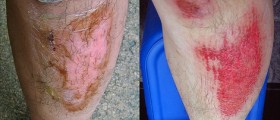


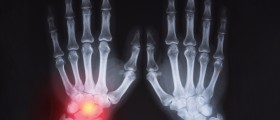

_f_280x120.jpg)
